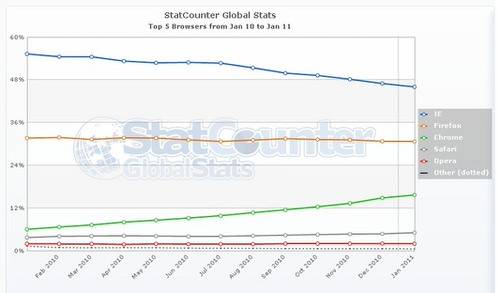
If there was one thing that seemed clear from today’s announcement of the Internet Explorer 9 Release Candidate, it’s that Microsoft is looking at Google’s Chrome as its primary competitor in the browser market.
Did they come out and say this? Of course not, but it was more in what Microsoft didn’t say today or at other recent IE9 events that really stood out. Not once did we hear the words “Mozilla” or “Firefox,” but we surely heard “Chrome.”
When we look at the stats for browser use worldwide, Internet Explorer has been on a slow decline, dropping from 55% a year ago to around 46% today. That’s a drop of nine percentage points. Chrome, on the other hand, has been on the rise, going from 6% a year ago to nearly 16% today. Where is Firefox? Steadily holding its ground in second place with a nearly consistent 30% of the browser market. Take a look:

The thing about this Internet is that it’s all about movement. Standing still is a form of death. The threat here isn’t coming from the steadily useful Firefox, it’s from the up-and-comer, Google Chrome.
What Microsoft Said (And Didn’t Say)
But let’s get back to the presentation today. Microsoft invited us all down to unveil the first release candidate for Internet Explorer 9 and showed off some of the usual features: HTML5 hardware-accelerated graphics and user interface.
Much of the talk around IE9 has been around moving the browser out of the way of the content. There are fewer menu buttons, icons, toolbars and status bars getting in the way. IE9 has gone minimalist and when Microsoft showed off the UI today, it did so by putting it side-by-side with Chrome.
When it came time to show off how quickly Internet Explorer 9 performed when faced with HTML5 graphics, it was also side-by-side with Chrome, not Firefox.
Only when we reached the topic of “do not track” lists and privacy did the topic of Firefox come up, as Mozilla is working on its own approach in this realm. In the realms of usability, design and performance, however, the only comparisons made were to Chrome.





















